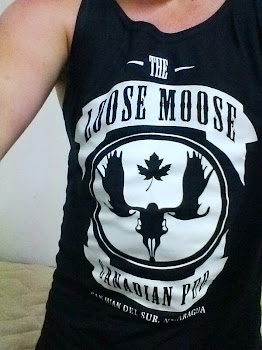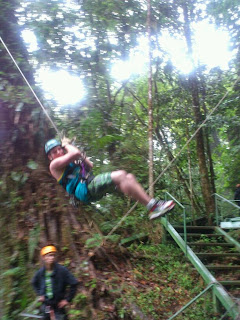When we arrived in San Juan del Sur, we were immediately greeted by a man speaking English with a North American accent asking if we needed a hostel. His name was Oscar and he had grown up in Chicago but had lived in Central America for several years. We ended up staying at the hostel he recommended and lived at, the Hospadeja Elizabeth, for our entire stay in San Juan. I initially liked Oscar. He was friendly, spoke good English, and had recommended us a good hostel. However, as I got to know him, my opinion quickly changed.
The first night, we asked if he had any dinner recommendations. He recommended a place called Cha Cha Cha's which had beers and appetizers for C$25 (equivalent to $1). He had told us to tell the server at the restaurant that Oscar had recommended it. Since she only spoke Spanish, we ended up not mentioning him as we didn't have the necessary Spanish skills to say that he had recommended it. While we were eating, Oscar arrived at the restaurant and told them that he had sent us. It seemed strange that he cared so much that they knew he had recommended it to us.
Later that evening, we mentioned to Oscar that we were interested in getting our open water certifications. He was all too eager to help and wasted no time going to the dive shop on our behalf. He arranged a meeting between the dive instructor and us and walked us to the dive shop the next morning. This behavior was unexpected, as we were fully capable of finding the dive shop ourselves and had planned to go to that shop anyways.
We later learned that Oscar's "job" is telling people where to go for various activities they are interested in doing. Oddly, he didn't ask us for money and his involvement didn't affect the price we paid at the hostel, restaurant, or dive shop. We eventually learned that he expects these organizations to pay him some sort of commission for his recommendation. He also complained to us that he often gets "ripped off" by people who refuse to pay him his commission. Throughout our time in San Juan, I discovered more about Oscar's story. I don't know for sure why he lives how he does, but it seems like he ran out of money while traveling in Central America and got stuck there. Then, as a broke American stuck in a foreign country, rather than get a legitimate job to afford a ticket back to America, he does minimal work and leeches off the hard work of local Nicaraguans. By the time we left, I had lost all respect for Oscar. He wanted to go to the dive shop with us when we went for our last dive to collect his commission. But what was his commission for? When we arrived in Nicaragua, we had already found the shop online and had planned to get certified. We would have gone there even if we had never met Oscar. All he did was walk us there once, but the dive shop was just around the corner. We would have found it without his involvement! On our last day of diving, we purposely went to the shop without Oscar. I would much rather our hard-working dive instructor, Fidel, get our money than some American leech who got stuck in Nicaragua, probably after making some poor life choices.
The first night, we asked if he had any dinner recommendations. He recommended a place called Cha Cha Cha's which had beers and appetizers for C$25 (equivalent to $1). He had told us to tell the server at the restaurant that Oscar had recommended it. Since she only spoke Spanish, we ended up not mentioning him as we didn't have the necessary Spanish skills to say that he had recommended it. While we were eating, Oscar arrived at the restaurant and told them that he had sent us. It seemed strange that he cared so much that they knew he had recommended it to us.
Later that evening, we mentioned to Oscar that we were interested in getting our open water certifications. He was all too eager to help and wasted no time going to the dive shop on our behalf. He arranged a meeting between the dive instructor and us and walked us to the dive shop the next morning. This behavior was unexpected, as we were fully capable of finding the dive shop ourselves and had planned to go to that shop anyways.
We later learned that Oscar's "job" is telling people where to go for various activities they are interested in doing. Oddly, he didn't ask us for money and his involvement didn't affect the price we paid at the hostel, restaurant, or dive shop. We eventually learned that he expects these organizations to pay him some sort of commission for his recommendation. He also complained to us that he often gets "ripped off" by people who refuse to pay him his commission. Throughout our time in San Juan, I discovered more about Oscar's story. I don't know for sure why he lives how he does, but it seems like he ran out of money while traveling in Central America and got stuck there. Then, as a broke American stuck in a foreign country, rather than get a legitimate job to afford a ticket back to America, he does minimal work and leeches off the hard work of local Nicaraguans. By the time we left, I had lost all respect for Oscar. He wanted to go to the dive shop with us when we went for our last dive to collect his commission. But what was his commission for? When we arrived in Nicaragua, we had already found the shop online and had planned to get certified. We would have gone there even if we had never met Oscar. All he did was walk us there once, but the dive shop was just around the corner. We would have found it without his involvement! On our last day of diving, we purposely went to the shop without Oscar. I would much rather our hard-working dive instructor, Fidel, get our money than some American leech who got stuck in Nicaragua, probably after making some poor life choices.





























